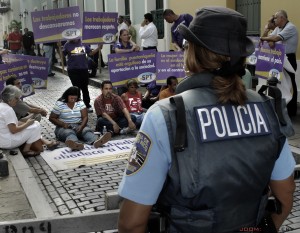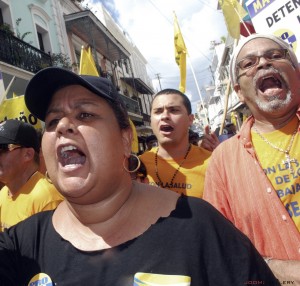This has been a very difficult week in Puerto Rico: governor Luis Fortuño layed-off nearly 17,000 government employees. In total this year, the recently elected government has laid off around 25,000 public employees. After the announcement, people immediately mobilized. Workers, women, students, professors, and members of the civil society in general, have organized press conferences and demonstrations in order to protest the decision that leaves thousands of families in a desperate situation. In an act of civil disobedience a group of people chained themselves and blocked the main entrance to the Governor's Mansion, La Fortaleza, in Old San Juan. They set up what they called “The Camp of Dignity”, but were soon removed by a special police force. Trade unions have announced a national strike for October 15.

Civil disobedients in front of the Governor's Mansion. Photo by José Antonio Rosado from Prensa Comunitaria.

Photo by José Antonio Rosado from Prensa Comunitaria.
There have also been acts of utter frustration. While leading a press conference in the eastern zone of the Island, the Governor was egged by a man called Roberto García. The Governor dodged the egg. García was charged on attempted assault and was set free on bail. He later said that even though he had voted for the Governor, he was extremely disappointed by his decision to lay off thousands of government employees. Women's organizations have denounced the lay-offs, saying that they disproportionately affect women, especially single mothers who are the only bread-winners of their families.

Demonstrations in San Juan. Photo by José Antonio Rosado from Prensa Comunitaria.
Comments and analysis on the precarious political, social and economic situation that Puerto Rico is enduring have flooded the blogosphere. Sergio Marxuach, Policy Director of the Center for the New Economy, a nonprofit think-tank dedicated to progressive economic solutions based in Puerto Rico, analyzed the situation in the organization's new blog [ES]:
Todos los economistas están de acuerdo que el resultado de despedir 20,000 empleados públicos en una recesión va a tener los siguientes efectos: 1. Aumentar la tasa de desempleo a mas de 18%;
2. Agudizar la recesión, ya que habrá 20,000 empleados menos, lo que reduce el consumo agregado;
3. Aumentar la demanda por servicios públicos, por ejemplo, educación y salud;
4. Desempleo prolongado ya que el sector privado no va a reclutar masivamente en medio de una recesión; y
5. En el caso específico de Puerto Rico, empeorar la situación los bancos, ya que 46% de los empleados públicos tienen hipoteca.
All of the economists agree that laying off 20,000 public employees during a recession will have the following effects:
1. An 18% increase of the unemployment rate;
2. Worsen the recession, because there will be 20,00 fewer employees, and that decreases aggregate consumption;
3. Increase the demand for public services, for example education and health;
4. Prolonged unemployment due to the fact that the private sector will not recruit massively in the middle of a recession;
5. In the specific case of Puerto Rico, local banks’ situations will worsen because 46% of public employees hold a mortgage.
In Ventanasur [ES], Reinaldo Millán comments:
El partido de gobierno está de plácemes, no tiene oposición y los medios de comunicación son de manufactura conservadora, lo que le ayuda enormemente ya que los inversionistas de los medios son parientes de los ejecutivos de empresas que se beneficiarán del mantengo corporativo de la ley de Alianzas Público Privadas, mediante la cual le transferirán no solo la responsabilidad de los servicios públicos que hagan falta ofrecer ante la eliminación de las agencias de gobierno sino la administración de fondos públicos que antes correspondían a esas dependencias gubernamentales.
The Government is utterly happy: they do not have a political opposition and the mainstream media are conservative. This helps them greatly because the major media investors are related to the executives of the firms that will benefit from the Public-Private Coalition Law. This law transfers the responsibility of certain public services to the private sector, and it also permits the private sector to administer public funds that were previously handled by public agencies that have been eliminated.

Demonstration in San Juan. Photo by José Antonio Rosado from Prensa Comunitaria.
In her blog Poder, espacio y ambiente [ES], lawyer Erika Fontánez questioned the reasons the Government offered in order to justify the lay-offs. Government officials said the cuts would ultimately benefit the population.
Necesitamos saber, por ejemplo, si variables como el género y los puestos que tradicionalmente responden a un género particular fueron tomadas en cuenta. ¿Sabemos cuantas de esas 17,000 son mujeres? ¿Cuántas madres solteras? ¿A cuanto asciende el % de mujeres desempleadas? ¿De qué sectores son? ¿Cuál es el costo de que más personas se queden eventualmente sin plan médico que cubra los servicios de salud? ¿Cuál es el número de los costos vs. los beneficios en atender más problemas de salud mental, del aumento en suicidios, de seguridad, de personas que se vean en el riesgo de perder sus viviendas y tengan que acudir a solicitar vivienda pública, lo que también está en el colapso? Números, sí, queremos números.
We need to know, for example, if variables such as gender and the jobs that women traditionally occupy were taken into account. Do we know how many of these 17,000 people are women? How many of them are single mothers? What is the percent of women? What sectors do they belong to? What are the costs to cover people who will eventually have no health plans? What is the number of costs vs. benefits of attending to more mental health problems, an increase in suicides, insecurity, of people who may lose their houses and may need public housing (which is also collapsing)? Numbers, yes, we want numbers.
PhD student in Planning and International Development, Deepak Lamba-Nieves, also offered his insights in (Trans)actions: (Trans)acciones:
Part of the measures to cut back on government spending have included: incentivized retirement packages, voluntary reductions of work hours, the suspension of previously negotiated collective bargaining agreements, and the layoff of public employees. Asides from these draconian measures, they have pounced over the poor and destitute by displacing residents from informal settlements, curtailing the advancement of progressive grassroots efforts, and deploying police riot squads to deal with minor manifestations of civilian unrest…For now, it’s hard to imagine how this chapter of the story will end. My impression is that a good number of people are fed up what’s happening in their country. Some feel the pain more than others, but as anyone who has been injured knows, after a while, and if things don’t improve, those around you start feeling your pain. I don’t think the current administration has a good grasp of what is at stake here. Public unrest can lead to many different negative outcomes and even if the economy starts bouncing back, certain damages (and images) are not so easy to remedy (or erase).
The photos by José Antonio Rosado are republished with permission of Prensa Comunitaria.







9 comments
I remember how elated those stupid little yankies were after the Fortuño’s election. They asked for a good wipping for their asses and now they have it. I did not vote for that asshole. When the PRicans are going to learn that the PNP is there for the rich and to distribute public wealth for the rich. They still believe that “Estadidad es para los pobres”. Silly kids